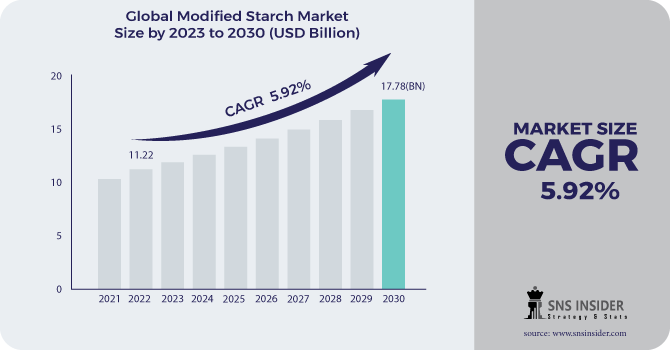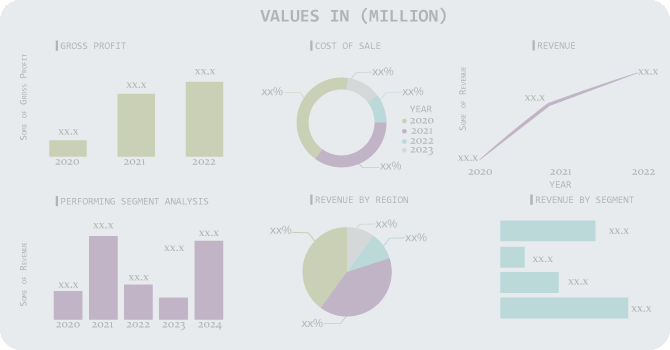Modified Starch Market Report Scope & Overview:
Modified Starch Market was valued at US$ 11.22 billion in 2022, and is projected to reach at US$ 17.78 billion by 2030, growing at a CAGR of 5.92% from 2023 to 2030.
Modified starch is framed by morphological or physiochemical changes in the design of local starch through its treatment with heat, acids, soluble bases, or proteins. These have further developed water-holding limit, heat opposition, restricting attributes, and thickening property. Maize, potato, wheat, and cassava are a portion of the vitally unrefined substances of modified starches.

Get more information on Modified Starch Market - Request Sample Report
Modified starches are generally utilized in the food and refreshment industry as thickening specialists, balancing out specialists, or emulsifying specialists because of their somewhat absorbable nature and nature of being Gluten-Free, consequently giving lesser fat than customary starches. The paper-production industry is one more principal utilization of modified starches, attributable to their limiting property for assembling high strength and upgraded quality paper with fitting surface estimating, covering, and calendaring. Additionally, drug, creature feed, materials, beauty care products, and different ventures likewise utilize modified starch.
Different handling strategies like physical, enzymatic, wet and dry substance processes, drum drying, and expulsion are utilized to deliver various kinds of modified starch items. These cycles are utilized to change the properties of local starch, for example, its freeze-defrost steadiness, corrosive or soluble base opposition, and shear strength to meet modern prerequisites. Modified starches are utilized for capacities like thickening, balancing out, restricting, and emulsification. Aside from food items, it is likewise utilized in a wide scope of non-food applications and the creature feed industry.
Market Dynamics:
Driving factors:
-
Rising interest for handled and comfort food.
-
Globalization and the resultant changing ways of.
Restraining factor:
-
Restricted sources and significant expense of normally added substances
-
The creation of cassava relies upon climatic circumstances.
Opportunities:
-
Expected elective wellsprings of modified starch
Challenges:
-
Endorsement from numerous administrative bodies
-
The administrative body's regulations and requirements among the business.
Impact of COVID-19:
The covid-19 pandemic generally affects organizations across different ventures in a brief time frame, including the food and refreshment store network. The greatest misguided judgment about covid-19 is that vacant staple racks are a marker that there is a deficiency of food because of the new sudden spikes in demand for supermarkets, which have made these momentary interruptions as the inventory network attempts to make up for lost time and recharge.
The pandemic will adversely affect the generally speaking modified starch market. The deals of handled and bundled food varieties have expanded as customers hurry to stock their storage rooms. It is normal that the covid-19 pandemic will expand the utilization of handled food varieties and other rack stable food varieties that have a more drawn-out time span of usability.
Besides, with the closure of different food service outlets and cafés across the globe because of cross country lockdown, buyers are constrained to cook at home. Subsequently, buyers reserve food items that can be effectively cooked and choose prepared to-eat food sources with a longer timeframe of realistic usability. Inferable from this, emphatically affecting the handled and bundled food industry is normal.
Key Market Segments:
By Raw Material:
- Potato
- Corn
- Cassava
- Wheat
- Other raw materials (rice bran, waxy maize etc.)
By Application:
- Food & beverages
- Bakery & confectionery
- Beverages
- Processed food
- Other food & beverages applications*(desserts, sauces, dressings etc.)
- Feed
- Ruminant feed
- Swine feed
- Poultry feed
- Other feed applications (cattle feed etc.)
- Industrial
- Paper making
- Weaving & textiles
- Medicines & pharmaceuticals
- Cosmetics
- Other industrial applications(personal care, hygiene etc.)
By form:
- Dry
- Liquid
By modification type:
- Physical modification
- Hydrothermal
- Non-hydrothermal
- Chemical modification
- Cationic starch
- Etherified starch
- Esterified starch
- Enzymatic modification
By function:
- Stabilizers
- Emulsifiers
- Binders
- Other functions
.png)
Get Customized Report as per your Business Requirement - Request For Customized Report
REGIONAL COVERAGE:
-
North America
-
USA
-
Canada
-
Mexico
-
-
Europe
-
Germany
-
UK
-
France
-
Italy
-
Spain
-
The Netherlands
-
Rest of Europe
-
-
Asia-Pacific
-
Japan
-
south Korea
-
China
-
India
-
Australia
-
Rest of Asia-Pacific
-
-
The Middle East & Africa
-
Israel
-
UAE
-
South Africa
-
Rest of Middle East & Africa
-
-
Latin America
-
Brazil
-
Argentina
-
Rest of Latin America
-
Today Asia-Pacific's is the world's driving maker of modified starch, with European modified starch being sent out to all edges of the globe. Asia-pacific represented a piece of the pie of 55.2% in the worldwide modified starch market, in 2021. The Asia-pacific starch industry has a scope of starch contributions, going from local to modified (artificially and truly) and fluid and strong sugars. The adaptability of potato starches empowers their application as fixings and useful enhancements in the food, non-food, and feed ventures.
As far as the end-use application industry, there is no stand-apart pattern. Notwithstanding, the food business is projected to observe the quickest development with the more current varieties of modified starch, new items, and a scope of utilization.
Key players:
Sms Corporation, Global Bio-Chem Technology Group Company Limited, Ingredion Incorporated , Archer Daniel Midlands Company , Cargill Incorporated , Tate & Lyle , Avebe u.a., Tereos , Lyckeby And Avebe).
Ingredion Incorporated-Company Financial Analysis

| Report Attributes | Details |
|---|---|
| Market Size in 2022 | US$ 11.22 Billion |
| Market Size by 2030 | US$ 17.78 Billion |
| CAGR | CAGR 5.92% From 2023 to 2030 |
| Base Year | 2022 |
| Forecast Period | 2023-2030 |
| Historical Data | 2020-2021 |
| Report Scope & Coverage | Market Size, Segments Analysis, Competitive Landscape, Regional Analysis, DROC & SWOT Analysis, Forecast Outlook |
| Key Segments | • by Raw Material (Corn, Cassava, Potato, Wheat) • by End-User (Food & Beverages, Feed, And Industrial) • by Form (Dry and Liquid) |
| Regional Analysis/Coverage | North America (USA, Canada, Mexico), Europe (Germany, UK, France, Italy, Spain, Netherlands, Rest of Europe), Asia-Pacific (Japan, South Korea, China, India, Australia, Rest of Asia-Pacific), The Middle East & Africa (Israel, UAE, South Africa, Rest of Middle East & Africa), Latin America (Brazil, Argentina, Rest of Latin America) |
| Company Profiles | Sms Corporation, Global Bio-Chem Technology Group Company Limited, Ingredion Incorporated, Archer Daniel Midlands Company, Cargill, Tate & Lyle, Avebe u.a., Tereos, Lyckeby And Avebe. |
| Key Drivers | •Rising interest for handled and comfort food. •Globalization and the resultant changing ways of. |
| Restraints | •Restricted sources and significant expense of normal added substances •The creation of cassava relies upon climatic circumstances. |

